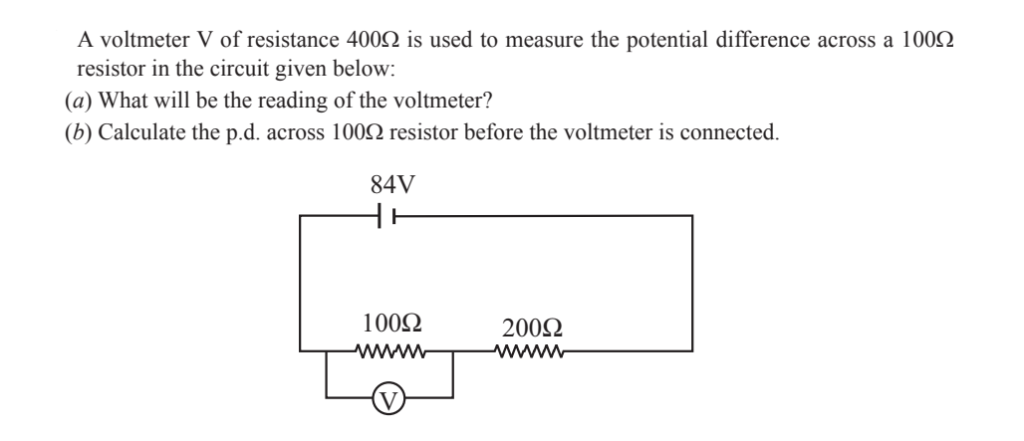
To solve this problem, we need to determine the reading of a voltmeter with a resistance of 400Ω when connected across a 100Ω resistor, which is in series with a 200Ω resistor. Both resistors are connected to an 84V source. We’ll also calculate the potential difference across the 100Ω resistor before the voltmeter was connected.
### Part (a): Voltmeter Reading
When the voltmeter is connected across the 100Ω resistor, the voltmeter and the resistor form a parallel combination. This parallel branch is in series with the 200Ω resistor.
1. **Total Resistance of the Parallel Branch**:
– ![]()
2. **Total Resistance of the Circuit**:
– ![]()
3. **Total Current through the Circuit**:
– ![]()
4. **Voltage across the Parallel Branch (Voltage read by the Voltmeter)**:
– ![]()
### Part (b): Voltage across the 100Ω Resistor Before Connecting the Voltmeter
Without the voltmeter, the resistors 100Ω and 200Ω are in series:
1. **Total Resistance without Voltmeter**:
– ![]()
2. **Total Current through the Circuit without Voltmeter**:
– ![]()
3. **Voltage across the 100Ω Resistor**:
– ![]()
Let’s perform the calculations now.
It seems there was an issue with the calculation. Let me try solving it again.
### Part (a): Voltmeter Reading
Given:
– Voltage source ![]()
– Resistances: ![]() ,
, ![]() ,
, ![]()
For the parallel combination of the 100Ω resistor and the voltmeter:
![]()
Total circuit resistance when the voltmeter is connected:
![]()
Total current through the circuit:
![]()
Voltage across the parallel branch (and the voltmeter reading):
![]()
### Part (b): Voltage across the 100Ω Resistor Before Connecting the Voltmeter
Total resistance of the 100Ω and 200Ω resistors in series:
![]()
Total current without the voltmeter:
![]()
Voltage across the 100Ω resistor before the voltmeter:
![]()
Let’s perform these calculations manually, given the system issue:
#### For Part (a):
1. ![]()
2. ![]()
3. ![]()
4. ![]()
#### For Part (b):
1. ![]()
2. ![]()
3. ![]()
Based on these manual calculations:
– The reading of the voltmeter (Part a) would be 24V.
– The voltage across the 100Ω resistor before connecting the voltmeter (Part b) would be 28V.